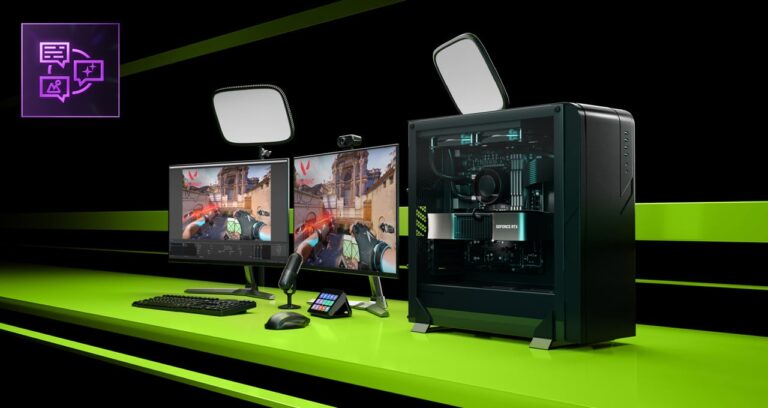At TwitchCon, the global convention for the Twitch livestreaming platform, livestreamers and content creators can experience the latest technology this week to accelerate their creative workflows and improve the quality of their videos.
This includes the beta release of Twitch Enhanced Broadcasting support for HEVC when using the NVIDIA encoder.
Content creators can also enhance their productions with the NVIDIA Broadcast app, 8th generation NVIDIA NVENC, and RTX-powered optimizations in streaming and video editing apps.
Additionally, the September NVIDIA Studio Drivers are now available for download, designed to optimize creative apps and are rigorously tested to ensure seamless compatibility while enhancing features, automating processes, and accelerating workflows.
Twitch Enhances Broadcasting with HEVC
The trade-off between high-definition video quality and reliable streaming is a common problem that live streamers struggle with.
Higher quality video provides a more enjoyable viewing experience, but viewers with lower bandwidth or older devices may experience buffering of the stream. Streaming lower bitrate video allows more people to watch your content seamlessly, but introduces artifacts that hinder viewing quality.
To address this issue, NVIDIA and Twitch partnered to develop Twitch Enhanced Broadcasting, which adds the ability to send multiple streams (different versions of your video encoded at different resolutions and bitrates) directly from your NVIDIA GeForce RTX-powered PC or NVIDIA RTX Workstation, allowing you to deliver the highest quality video your viewers’ Internet connections can handle.
Twitch supports HEVC (H.265) in its Enhanced Broadcasting closed beta. Using the NVIDIA encoder, Twitch streamers will see a 25% increase in efficiency and quality compared to H.264.
This means your video will appear as if it’s being streamed at a 25% higher bitrate, resulting in better quality and fewer artifacts and encoding errors. This feature is ideal for streaming fast-paced gameplay, delivering cleaner, sharper video with minimal lag.
All stream versions are generated by a dedicated hardware encoder on your GeForce RTX GPU, so the rest of your system’s GPU and CPU can focus on making your game run more smoothly and maximizing performance.
Learn how to get started at twitch.com.
AI-enhanced microphone and webcam
NVIDIA technology makes streaming easier than ever.
First, the performance and video quality on your PC is amazingly high thanks to NVIDIA’s dedicated encoder, and NVIDIA GPUs contain Tensor Cores to efficiently run AI.
Livestreamers can use AI to enhance their hardware peripherals and devices, which is especially useful for those who don’t have the time or resources to put together an extensive audio and video setup.
NVIDIA Broadcast turns your home office or dorm room into a home studio without buying special equipment. AI-powered features include microphone noise and echo removal, camera virtual background, auto frame, video noise removal, eye contact, and more.
Livestreamers can download the Broadcast app or access the effects in popular creative apps such as Corsair iCUE, Elgato Camera Hub, OBS, Streamlabs, VTube Studio and Wave Link.
Spotlight on the highlights
With GeForce RTX GPUs, you can edit and enhance your video footage superfast in the most popular video editing apps, from Adobe Premiere Pro to CapCut Pro.
Streamers can use AI-powered RTX-accelerated features like Speech Enhancement, which removes noise to improve the quality of dialogue clips; Auto Reframe, which automatically resizes social media videos; and Scene Edit Detection, which splits long videos, such as continuous B-roll, into separate clips.
NVIDIA encoders accelerate the export process: For users who want the ultimate performance, GeForce RTX 4070 Ti GPUs and above feature dual encoders that work in parallel to cut export times in half in apps like CapCut, the most widely used video editing app on TikTok.
RTX Video Delivers a Clearer, Sharper Viewing Experience
Available exclusively to NVIDIA and GeForce RTX GPU owners, NVIDIA RTX Video can transform any online and native video into vivid 4K high dynamic range (HDR) content using two technologies: Video Super Resolution and Video HDR.
RTX Video Super Resolution removes artifacts and upscales streaming video, removing errors introduced during encoding or transmission, and then performs the AI Super Resolution effect. The result is cleaner, clearer video that’s ideal for streaming on platforms like YouTube and Twitch.
Many people have HDR displays, but there isn’t much HDR content online. RTX Video HDR solves this problem by converting standard dynamic range (SDR) video to HDR10 quality, which increases the range of light and dark, making visuals more vibrant and colorful. This feature is especially useful when watching dark scenes in video games.
RTX Video HDR requires an RTX GPU connected to an HDR10 capable monitor or TV. See the RTX Video FAQ for more information.
For the latest streaming updates, tune into TwitchCon, taking place in San Diego and online from September 20-22.

